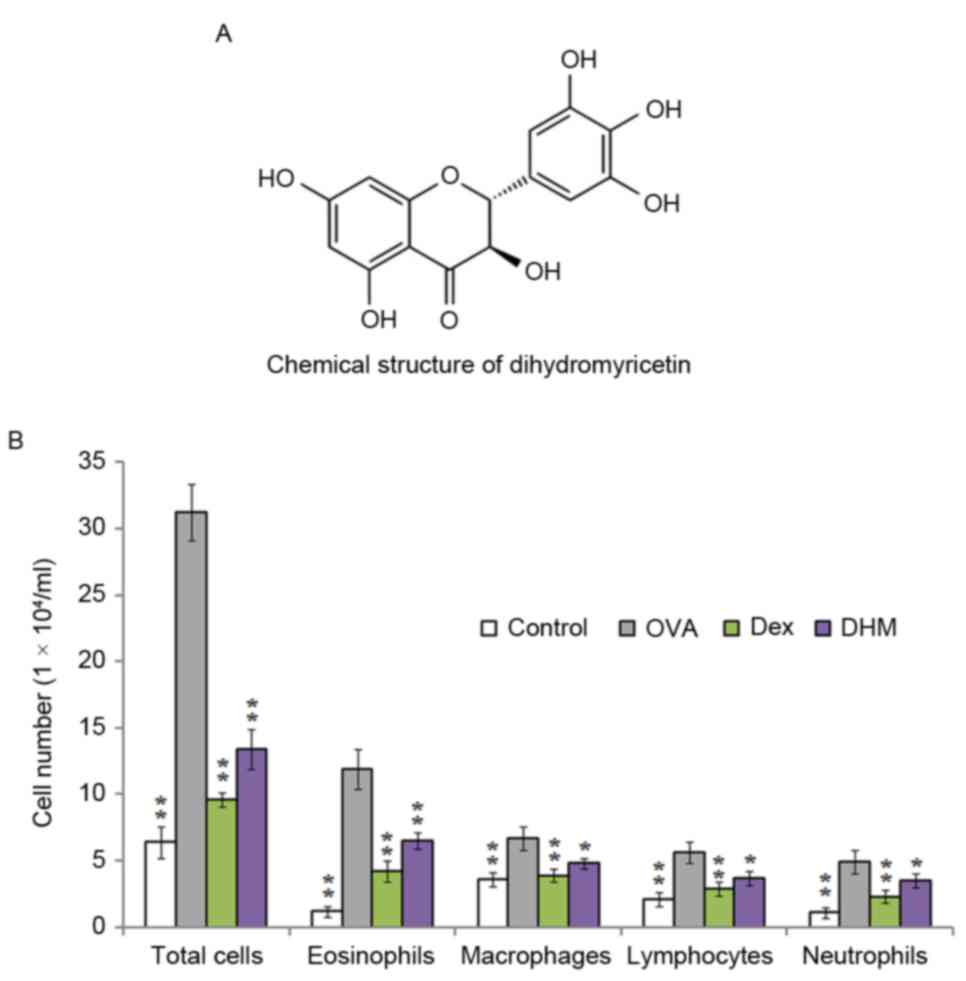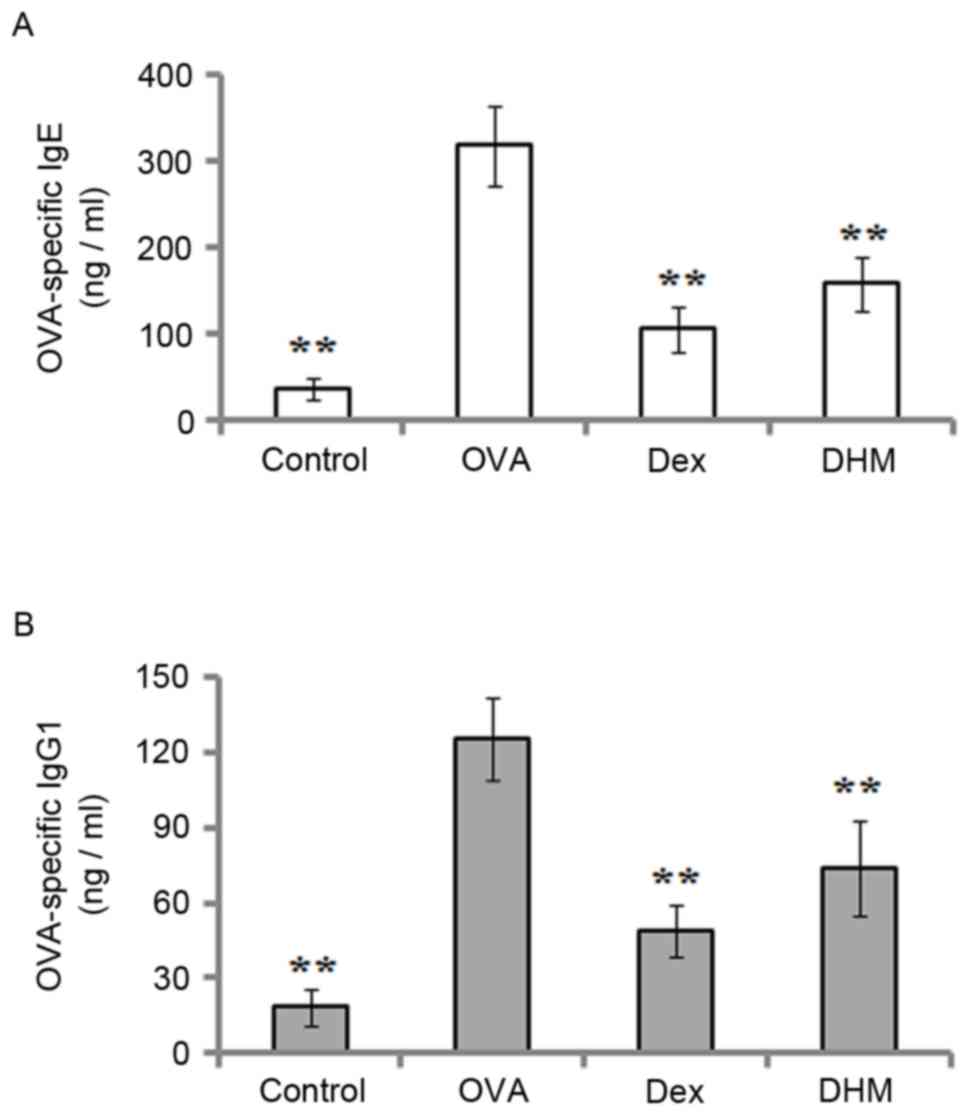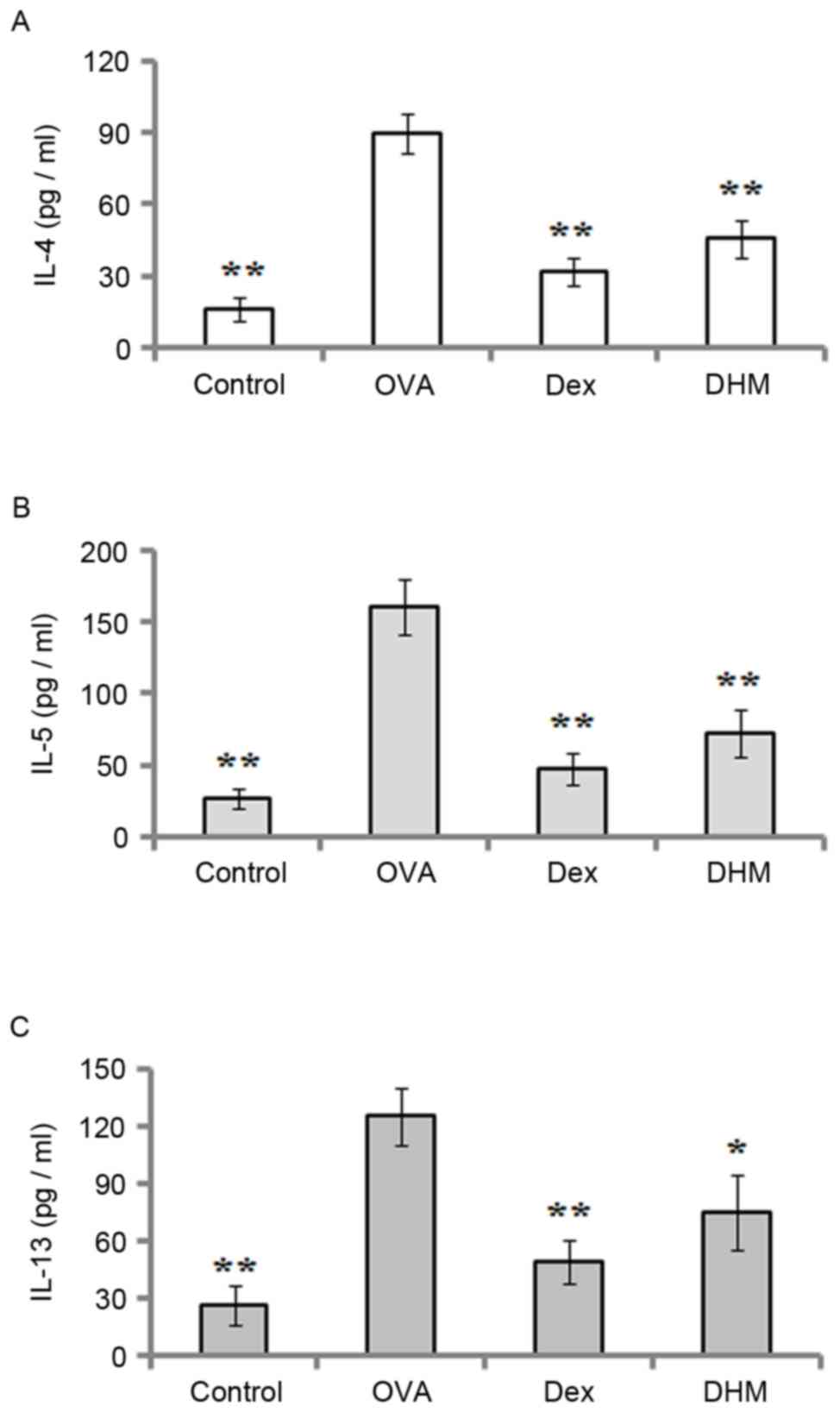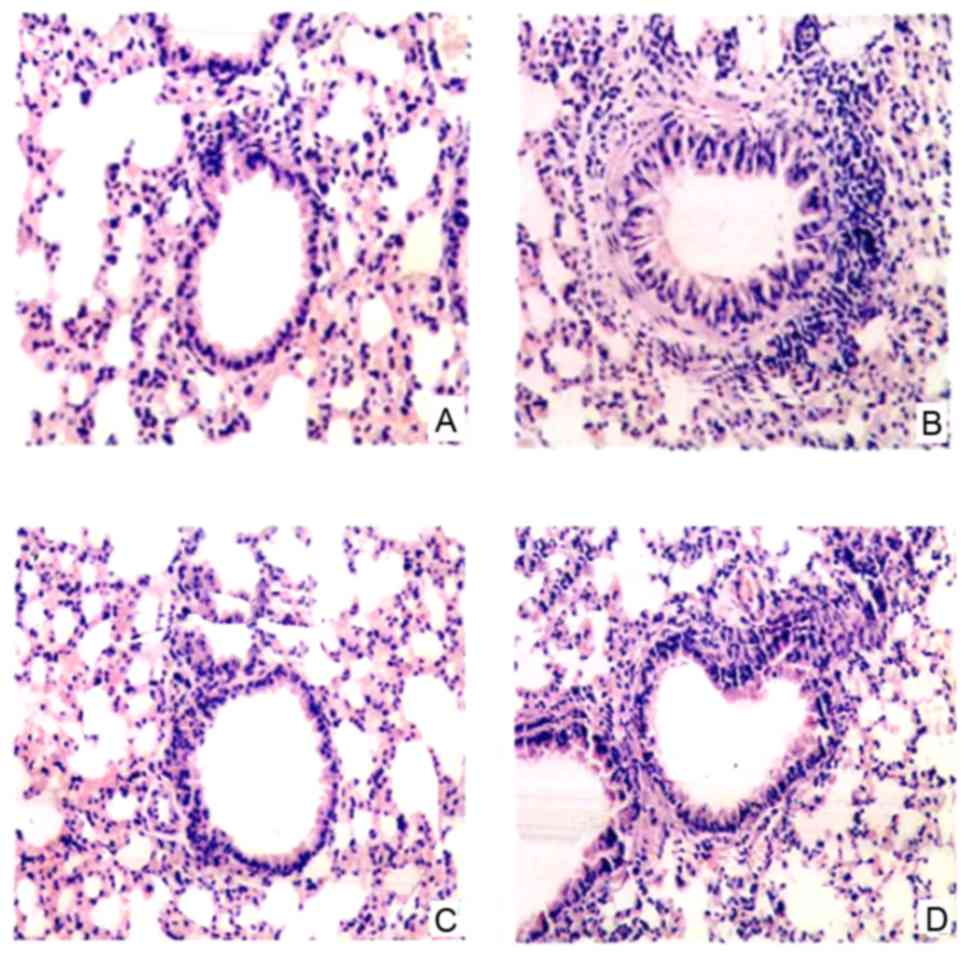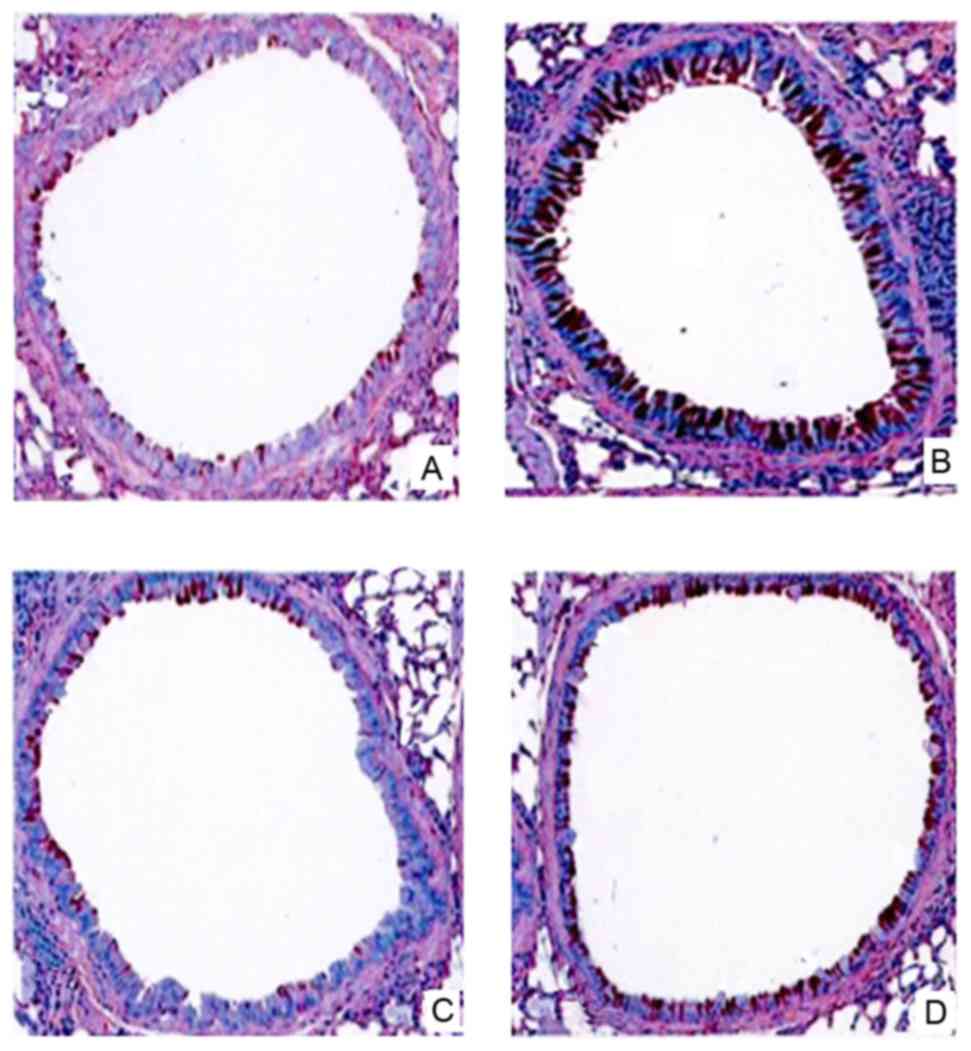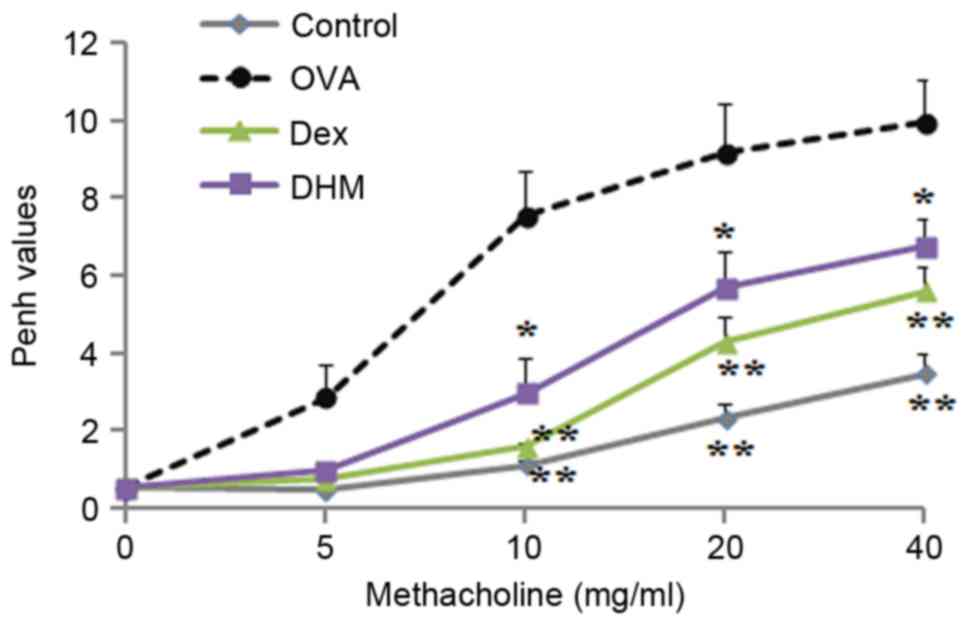|
1
|
Deveci F, Muz MH, Ilhan N, Kirkil G,
Turgut T and Akpolat N: Evaluation of the anti-inflammatory effect
of infliximab in a mouse model of acute asthma. Respirology.
13:488–497. 2008. View Article : Google Scholar : PubMed/NCBI
|
|
2
|
Ci X, Chu X, Xiang H, Li X and Deng X:
Anti-inflammatory effects of tilmicosin in a noninfectious mouse
model of allergic asthma. Immunopharmacol Immunotoxicol.
33:626–632. 2011. View Article : Google Scholar : PubMed/NCBI
|
|
3
|
Munroe ME, Businga TR, Kline JN and Bishop
GA: Anti-inflammatory effects of the neurotransmitter agonist
Honokiol in a mouse model of allergic asthma. J Immunol.
185:5586–5597. 2010. View Article : Google Scholar : PubMed/NCBI
|
|
4
|
Lee SH, Kim DW, Kim HR, Woo SJ, Kim SM, Jo
HS, Jeon SG, Cho SW, Park JH, Won MH, et al: Anti-inflammatory
effects of Tat-Annexin protein on ovalbumin-induced airway
inflammation in a mouse model of asthma. Biochem Biophys Res
Commun. 417:1024–1029. 2012. View Article : Google Scholar : PubMed/NCBI
|
|
5
|
Murad HA and Hasanin AH: The
anti-inflammatory effects of 1,1 dimethyl-4-phenylpiperazinium
(DMPP) compared to dexamethasone in a guinea pig model of ovalbumin
induced asthma. Eur Rev Med Pharmacol Sci. 18:2228–2236.
2014.PubMed/NCBI
|
|
6
|
Kim DY, Park BS, Hong GU, Lee BJ, Park JW,
Kim SY and Ro JY: Anti-inflammatory effects of the R2 peptide, an
inhibitor of transglutaminase 2, in a mouse model of allergic
asthma, induced by ovalbumin. Br J Pharmacol. 162:210–225. 2011.
View Article : Google Scholar : PubMed/NCBI
|
|
7
|
Zeng G, Liu J, Chen H, Liu B, Zhang Q, Li
M and Zhu R: Dihydromyricetin induces cell cycle arrest and
apoptosis in melanoma SK-MEL-28 cells. Oncol Rep. 31:2713–2719.
2014.PubMed/NCBI
|
|
8
|
Shen Y, Lindemeyer AK, Gonzalez C, Shao
XM, Spigelman I, Olsen RW and Liang J: Dihydromyricetin as a novel
anti-alcohol intoxication medication. J Neurosci. 32:390–401. 2012.
View Article : Google Scholar : PubMed/NCBI
|
|
9
|
Ni F, Gong Y, Li L, Abdolmaleky HM and
Zhou JR: Flavonoid ampelopsin inhibits the growth and metastasis of
prostate cancer in vitro and in mice. PLoS One. 7:e388022012.
View Article : Google Scholar : PubMed/NCBI
|
|
10
|
Huang H, Hu M, Zhao R, Li P and Li M:
Dihydromyricetin suppresses the proliferation of hepatocellular
carcinoma cells by inducing G2/M arrest through the
Chk1/Chk2/Cdc25C pathway. Oncol Rep. 30:2467–2475. 2013.PubMed/NCBI
|
|
11
|
Murakami T, Miyakoshi M, Araho D, Mizutani
K, Kambara T, Ikeda T, Chou WH, Inukai M, Takenaka A and Igarashi
K: Hepatoprotective activity of tocha, the stems and leaves of
Ampelopsis grossedentata, and ampelopsin. Biofactors. 21:175–178.
2004. View Article : Google Scholar : PubMed/NCBI
|
|
12
|
Liang J, Shen Y, Shao XM, Scott MB, Ly E,
Wong S, Nguyen A, Tan K, Kwon B, Olsen RW and Spigelman I:
Dihydromyricetin prevents fetal alcohol exposure-induced behavioral
and physiological deficits: The roles of GABAA receptors in
adolescence. Neurochem Res. 39:1147–1161. 2014. View Article : Google Scholar : PubMed/NCBI
|
|
13
|
Meng G, Yang S, Chen Y, Yao W, Zhu H and
Zhang W: Attenuating effects of dihydromyricetin on angiotensin
II-induced rat cardiomyocyte hypertrophy related to antioxidative
activity in a NO-dependent manner. Pharm Biol. 53:904–912. 2015.
View Article : Google Scholar : PubMed/NCBI
|
|
14
|
Jiang B, Le L, Pan H, Hu K, Xu L and Xiao
P: Dihydromyricetin ameliorates the oxidative stress response
induced by methylglyoxal via the AMPK/GLUT4 signaling pathway in
PC12 cells. Brain Res Bull. 109:117–126. 2014. View Article : Google Scholar : PubMed/NCBI
|
|
15
|
Liao W, Ning Z, Ma L, Yin X, Wei Q, Yuan
E, Yang J and Ren J: Recrystallization of dihydromyricetin from
Ampelopsis grossedentata and its anti-oxidant activity evaluation.
Rejuvenation Res. 17:422–429. 2014. View Article : Google Scholar : PubMed/NCBI
|
|
16
|
Zhao Z, Yin JQ, Wu MS, Song G, Xie XB, Zou
C, Tang Q, Wu Y, Lu J, Wang Y, et al: Dihydromyricetin activates
AMP-activated protein kinase and P38(MAPK) exerting antitumor
potential in osteosarcoma. Cancer Prev Res. 7:927–938. 2014.
View Article : Google Scholar
|
|
17
|
Zhu H, Luo P, Fu Y, Wang J, Dai J, Shao J,
Yang X, Chang L, Weng Q, Yang B and He Q: Dihydromyricetin prevents
cardiotoxicity and enhances anticancer activity induced by
adriamycin. Oncotarget. 6:3254–3267. 2015. View Article : Google Scholar : PubMed/NCBI
|
|
18
|
Chen S, Zhao X, Wan J, Ran L, Qin Y, Wang
X, Gao Y, Shu F, Zhang Y, Liu P, et al: Dihydromyricetin improves
glucose and lipid metabolism and exerts anti-inflammatory effects
in nonalcoholic fatty liver disease: A randomized controlled trial.
Pharmacol Res. 99:74–81. 2015. View Article : Google Scholar : PubMed/NCBI
|
|
19
|
Qi S, Xin Y, Guo Y, Diao Y, Kou X, Luo L
and Yin Z: Ampelopsin reduces endotoxic inflammation via repressing
ROS-mediated activation of PI3K/Akt/NF-κB signaling pathways. Int
Immunopharmacol. 12:278–287. 2012. View Article : Google Scholar : PubMed/NCBI
|
|
20
|
Hou XL, Tong Q, Wang WQ, Shi CY, Xiong W,
Chen J, Liu X and Fang JG: Suppression of inflammatory responses by
dihydromyricetin, a flavonoid from ampelopsis grossedentata, via
inhibiting the activation of NF-κB and MAPK signaling pathways. J
Nat Prod. 78:1689–1696. 2015. View Article : Google Scholar : PubMed/NCBI
|
|
21
|
Yang EJ, Lee JS, Yun CY, Ryang YS, Kim JB
and Kim IS: Suppression of ovalbumin-induced airway inflammatory
responses in a mouse model of asthma by Mimosa pudica extract.
Phytother Res. 25:59–66. 2011. View
Article : Google Scholar : PubMed/NCBI
|
|
22
|
Duan W, Chan JH, Wong CH, Leung BP and
Wong WS: Anti-inflammatory effects of mitogen-activated protein
kinase kinase inhibitor U0126 in an asthma mouse model. J Immunol.
172:7053–7059. 2004. View Article : Google Scholar : PubMed/NCBI
|
|
23
|
Lee M, Kim S, Kwon OK, Oh SR, Lee HK and
Ahn K: Anti-inflammatory and anti-asthmatic effects of resveratrol,
a polyphenolic stilbene, in a mouse model of allergic asthma. Int
Immunopharmacol. 9:418–424. 2009. View Article : Google Scholar : PubMed/NCBI
|
|
24
|
Bisset LR and Schmid-Grendelmeier P:
Chemokines and their receptors in the pathogenesis of allergic
asthma: Progress and perspective. Curr Opin Pulm Med. 11:35–42.
2005. View Article : Google Scholar : PubMed/NCBI
|
|
25
|
Nakajima H and Takatsu K: Role of
cytokines in allergic airway inflammation. Int Arch Allergy
Immunol. 142:265–273. 2007. View Article : Google Scholar : PubMed/NCBI
|
|
26
|
Ngoc PL, Gold DR, Tzianabos AO, Weiss ST
and Celedón JC: Cytokines, allergy, and asthma. Curr Opin Allergy
Clin Immunol. 5:161–166. 2005. View Article : Google Scholar : PubMed/NCBI
|
|
27
|
Elias JA, Lee CG, Zheng T, Ma B, Homer RJ
and Zhu Z: New insights into the pathogenesis of asthma. J Clin
Invest. 111:291–297. 2003. View
Article : Google Scholar : PubMed/NCBI
|
|
28
|
Yan S, Ci X, Chen N, Chen C, Li X, Chu X,
Li J and Deng X: Anti-inflammatory effects of ivermectin in mouse
model of allergic asthma. Inflamm Res. 60:589–596. 2011. View Article : Google Scholar : PubMed/NCBI
|
|
29
|
Palmqvist C, Wardlaw AJ and Bradding P:
Chemokines and their receptors as potential targets for the
treatment of asthma. Br J Pharmacol. 151:725–736. 2007. View Article : Google Scholar : PubMed/NCBI
|
|
30
|
Rosenberg HF, Phipps S and Foster PS:
Eosinophil trafficking in allergy and asthma. J Allergy Clin
Immunol. 119:1303–1312. 2007. View Article : Google Scholar : PubMed/NCBI
|
|
31
|
Kim DY, Ryu SY, Lim JY, Lee YS and Ro JY:
Anti-inflammatory mechanism of simvastatin in mouse allergic asthma
model. Eur J Pharmacol. 557:76–86. 2007. View Article : Google Scholar : PubMed/NCBI
|
|
32
|
Jia GQ, Gonzalo JA, Hidalgo A, Wagner D,
Cybulsky M and Gutierrez-Ramos JC: Selective eosinophil
transendothelial migration triggered by eotaxin via modulation of
Mac-1/ICAM-1 and VLA-4/VCAM-1 interactions. Int Immunol. 11:1–10.
1999. View Article : Google Scholar : PubMed/NCBI
|
|
33
|
Woodruff PG and Fahy JV: A role for
neutrophils in asthma? Am J Med. 112:498–500. 2002. View Article : Google Scholar : PubMed/NCBI
|
|
34
|
Wu AY, Chik SC, Chan AW, Li Z, Tsang KW
and Li W: Anti-inflammatory effects of high-dose montelukast in an
animal model of acute asthma. Clin Exp Allergy. 33:359–366. 2003.
View Article : Google Scholar : PubMed/NCBI
|
|
35
|
Coyle AJ, Wagner K, Bertrand C, Tsuyuki S,
Bews J and Heusser C: Central role of immunoglobulin (Ig) E in the
induction of lung eosinophil infiltration and T helper 2 cell
cytokine production: Inhibition by a non-anaphylactogenic anti-IgE
antibody. J Exp Med. 183:1303–1310. 1996. View Article : Google Scholar : PubMed/NCBI
|
|
36
|
Vargaftig BB and Singer M: Leukotrienes
mediate murine bronchopulmonary hyperreactivity, inflammation, and
part of mucosal metaplasia and tissue injury induced by recombinant
murine interleukin-13. Am J Respir Cell Mol Biol. 28:410–419. 2003.
View Article : Google Scholar : PubMed/NCBI
|
|
37
|
Taube C, Duez C, Cui ZH, Takeda K, Rha YH,
Park JW, Balhorn A, Donaldson DD, Dakhama A and Gelfand EW: The
role of IL-13 in established allergic airway disease. J Immunol.
169:6482–6489. 2002. View Article : Google Scholar : PubMed/NCBI
|
|
38
|
Inoue H, Kato R, Fukuyama S, Nonami A,
Taniguchi K, Matsumoto K, Nakano T, Tsuda M, Matsumura M, Kubo M,
et al: Spred-1 negatively regulates allergen-induced airway
eosinophilia and hyperresponsiveness. J Exp Med. 201:73–82. 2005.
View Article : Google Scholar : PubMed/NCBI
|
|
39
|
Zhu Q, Xu X, Liu X, Lin J, Kan Y, Zhong Y,
Liu F and Xu J: Sodium houttuyfonate inhibits inflammation by
blocking the MAPKs/NF-κB signaling pathways in bovine endometrial
epithelial cells. Res Vet Sci. 100:245–251. 2015. View Article : Google Scholar : PubMed/NCBI
|
|
40
|
Wu H, Zhao G, Jiang K, Chen X, Rui G, Qiu
C, Guo M and Deng G: IFN-τ alleviates lipopolysaccharide-induced
inflammation by suppressing NF-κB and MAPKs pathway activation in
mice. Inflammation. 39:1141–1150. 2016.PubMed/NCBI
|
|
41
|
Sheller JR, Polosukhin VV, Mitchell D,
Cheng DS, Peebles RS and Blackwell TS: Nuclear factor kappa B
induction in airway epithelium increases lung inflammation in
allergen-challenged mice. Exp Lung Res. 35:883–895. 2009.
View Article : Google Scholar : PubMed/NCBI
|
|
42
|
Tang N, Ma J, Wang KS, Mi C, Lv Y, Piao
LX, Xu GH, Li X, Lee JJ and Jin X: Dihydromyricetin suppresses
TNF-α-induced NF-κB activation and target gene expression. Mol Cell
Biochem. 422:11–20. 2016. View Article : Google Scholar : PubMed/NCBI
|



